One day I bough a very cheap quite nice looking (if you like Apple style) very cheap (2 USD) USB charger from dx.com. I was curious to see if anything useful could be built this cheaply. The product USB Power Charger Adapter – White (EU Plug / 100~240V) carried SKU 176662 code, but there does not seem to be any product with that code for sale anymore.
View of the other side:
Here the device promises 5V 1A out and says to take 100-240V 50/60 Hz. This is very small and looks good. There does not seem to be CE marking here, but there is US safety approval mark (UL).
I also did a quick insulation testing, no problem in withstanding 1000V DC insulation testing (=no immediate electrocution danger). On initial tests seemed to give out 5V at around 1A without problems for some time.
The device worked well to charge devices that took 200 mA or less current. But the device failed when taken into real use: I tried charging a Samsung smart phone (takes around 800-900 mA maximum current), but the device failed after around 15-20 minutes of continuous use. It stopped giving power out. I smelled slight burned electronics aroma. The charger was broken. It did not full-fill the promise.
So next task was to check what went wrong in the device. The case opened easily (too easily?) with small screwdriver and not much force. The electronics was easy to pull out. Looks a bit tightly packed here:
Here is a better look at the electronics inside:
What you can see is that electronics is very simple. On the high voltage side there are 2 diodes, 2 electrolytic capacitors (2.2uF2400V and 22uF25V), transformer, 2 resistor, 2 ceramic capacitors, 3 resistors and 1 transistor (MJE 13001 = NPN 600V/400V 0.2A). There is no control ICs anywhere!
On the low voltage side there are 1 diode, electrolytic capacitor (470uF10V), 1 zener diode, 1 optoisolator (817C), 1 resistor and USB connector.
Here are some findings on the circuit: The power supply is built using very simple circuit (simpler than expected). There is half-wave rectifier on the mains input. The switching ransformer seems to have 1 secondary coil (2 pins) and 2 primary side coils (4 pins). Looks like self-oscillating transformer-transistor circuit that is turned off by optoisolator when output voltage reaches the limit (slightly over 5V).
There are two worrying safety issues here: The insulation distances on the circuit board are very small (less than 1 mm on several places between mains side and output). Too small to be safe! There does not seem to be any fuse in this circuit! Mains power goes directly from input rectifier diode to mains storage capacitor (2.2uF400V). The question is what happens when this device is overloaded or some component fails.
The end result is that this was again another cheap unsafe power supply. I think there are good reasons for the product to be not anymore available.
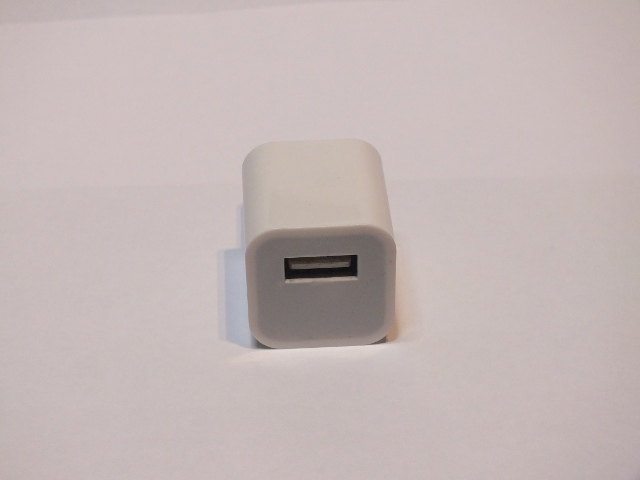
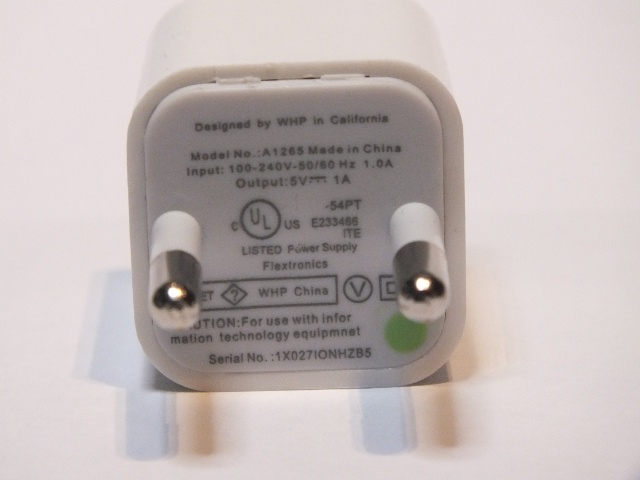
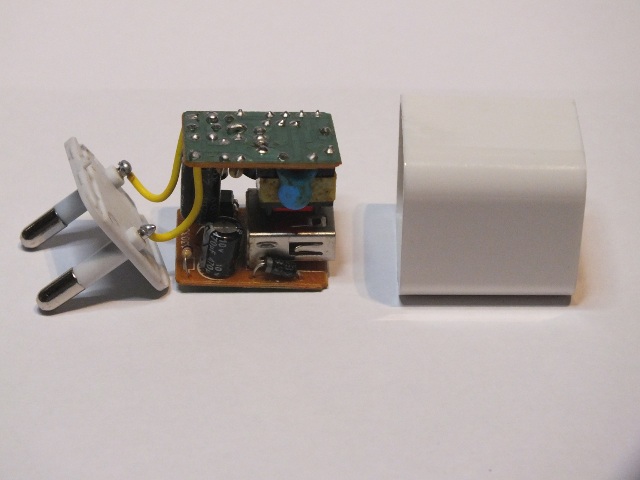
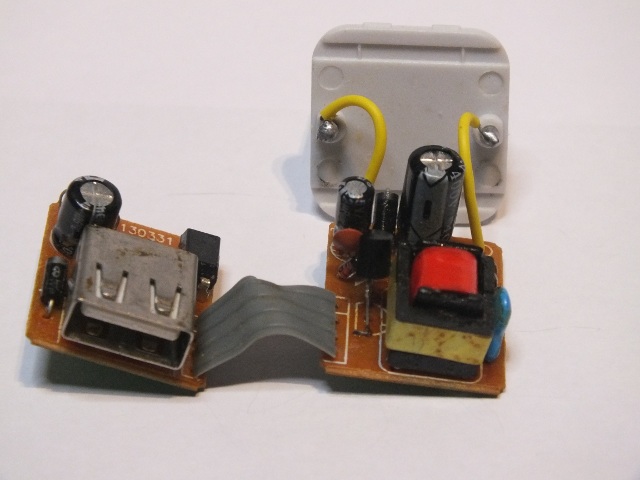
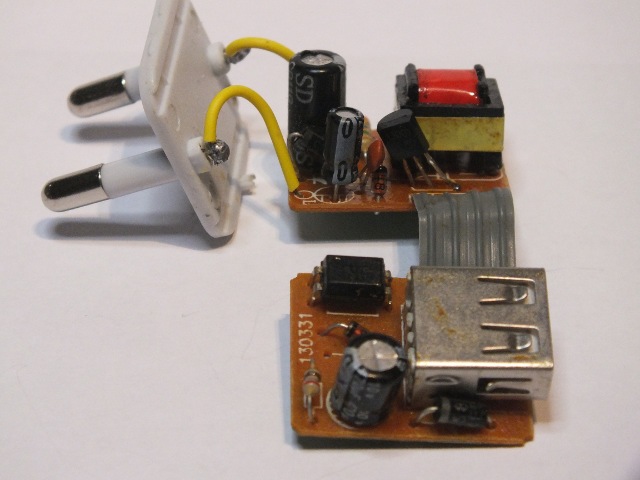
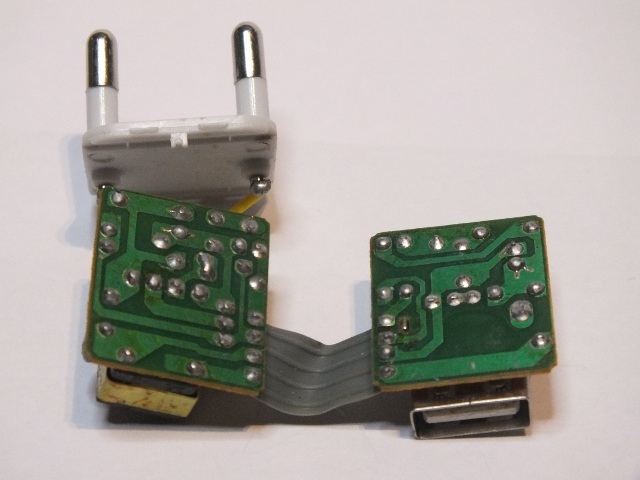
23 Comments
Electricians Auckland says:
Always handy to know whats on the inside and how it all works….cheers!
Taiwan Products says:
Cheap USB charger really unsafe
Tomi Engdahl says:
Powerless: Fake iPhone charger and cable
Teardown
http://www.edn.com/electronics-blogs/rowe-s-and-columns/4426482/2/Powerless–Fake-iPhone-charger-and-cable
Tomi Engdahl says:
This looks quite similar to my power supply…
EEVblog #388 – Fake Apple USB Charger Teardown
https://www.youtube.com/watch?v=wi-b9k-0KfE
Robert.SK says:
Hello, is this Samsung portable charger real or fake ? purchased in store…
http://rodi.sk/blog/samsung-eta-u90ewe-001.html
thanks
Tomi Engdahl says:
Thank you for your feedback.
I can’t say for sure because i have not looked what is inside original Samsung charger….
Based on your teardown pics the build quality looks OK.
Tomi Engdahl says:
A look inside a (crap) double gang socket with USB outlets.
https://www.youtube.com/watch?v=zoZ1_aEDPos
analysis when it failed to charge the original users devices. I think it’s probably a good idea the original owner got rid of it, since it has a rather unique earthing arrangement.
Tomi Engdahl says:
99% of fake Apple chargers fail a basic safety test, new study says
http://www.businessinsider.com/apple-fake-chargers-study-2016-12?r=US&IR=T&IR=T
It should go without saying, but if you buy a spare charger for an Apple device, you should absolutely make sure it’s from a known, reputable company.
Your latest reminder of this comes from the Chartered Trading Standards Institute, a UK consumer protection organization that teamed up with Illinois-based safety testers UL to examine 400 “counterfeit Apple chargers” from various suppliers.
According to the study, all but three of the 400 counterfeit chargers failed a “basic” safety test, in which high voltages were applied to the chargers to see if they had enough isolation to protect against electric shocks.
The study comes just a few weeks after Apple reportedly conducted its own study on third-party power accessories, and found that roughly 90% of Apple chargers and cables sold through Amazon were unsafe.
Whatever the case, fake chargers are still more common than they should be today.
Getting chargers and cables directly from Apple is the easiest thing to do. Especially on the cable side, if you don’t want to pay the premium Apple often slaps on, look for accessories with Apple’s MFi (Made for iPhone/iPad/iPod) certification on its packaging.
COUNTERFEIT IPHONE ADAPTERS
A UL TECHNICAL INVESTIGATION SHOWS A 99 PERCENT FAILURE RATE
http://library.ul.com/wp-content/uploads/sites/40/2016/09/10314-CounterfeitiPhone-WP-HighRes_FINAL.pdf
Tomi Engdahl says:
Similar looking USB charger also analyzed here:
USB Power Supply/charger Test
http://www.lygte-info.dk/info/usbPowerSupplyTest%20UK.html
Tomi Engdahl says:
http://www.righto.com/2012/10/a-dozen-usb-chargers-in-lab-apple-is.html
Tomi Engdahl says:
A dozen USB chargers in the lab: Apple is very good, but not quite the best
http://www.righto.com/2012/10/a-dozen-usb-chargers-in-lab-apple-is.html
Conclusions
So what charger should you spend your hard-earned money on? First, make sure the charger will work with your phone – for instance, newer iPhones only work with certain chargers. Second, don’t buy a counterfeit charger; the price is great, but it’s not worth risking your expensive device or your safety. Beyond that, it’s your decision on how much quality is worth versus price, and I hope the data here helps you make a decision
Tomi Engdahl says:
Really dodgy pink USB charger.
https://www.youtube.com/watch?v=wqJnFhhPAis
I was originally going to do a teardown on this, but the cramped circuitry and breathtakingly negligible safety tolerances ruled it out as a viable device from the start. I don’t think that having a PCB gap of 0.25mm or 0.01″ is really safe at all. Particularly when the gap between the two pads involved had a little line of flux impregnated with solder globs. Such a small clearance between the mains circuitry and the USB connector itself is just appalling. It really poses a shock risk for anyone touching a device with exposed “grounded” metal plugged into a charger like this.
Tomi Engdahl says:
Deadly USB Charger (Fake Apple) + Explosions
https://www.youtube.com/watch?v=nMmySM2nar8
A deadly dangerous USB charger (fake Apple iPhone charger) from China. Sold on Ebay for 90 cents including shipping. The PCB board has only 1mm distance between primary and secondary side. The EMI capacitor between primary and secondary side is only rated 1kV (should be Y1 class with a test voltage of 8kV). The transformer isolation is also questionable. The power supply has no fuse (just mains-bridge-electrolyte!). This poses serious risk of fire. When the power transistor shorts out (and it is likely to do so, because there’s no snubber network), the primary of the switching transistor gets essentially connected to mains with no fusing. This is likely to cause a meltdown of the transformer and get mains to the output.
Tomi Engdahl says:
Dangerous & Useless Cube USB Charger
https://www.youtube.com/watch?v=2RLMLLdbnz0
Another dangerous USB charger. This one is even worse than the previous one. Not only it is dangerous (can cause electric shock or fire), it is also completely useless. It can’t supply the 1A current at 5V. At 0.5A the voltage already drops to 2.7V. The separation of primary and secondary side is only 0.5mm on the PCB. The transformer also looks dodgy and the tiny EMI capacitor (connecting primary to secondary) is only rated 1kV.
There are two boards connected with a cable containing both primary and secondary side. Components on one board are touching components on the other board. This is definitely an electrocution device.
Tomi Engdahl says:
Inside some dodgy Chinese USB power supplies from Greece.
https://www.youtube.com/watch?v=bNoGCdX1IdQ
The flat one has one of the scariest transformers yet with no extra insulation between the secondary and sense windings. It also had a rather odd output capability of around just 20mA before the voltage plummeted.
Tomi Engdahl says:
EEVblog #388 – Fake Apple USB Charger Teardown
https://www.youtube.com/watch?v=wi-b9k-0KfE
Teardown Tuesday.
What is inside a fake clone A1265 Apple USB charger?
WARNING: These fakes and cheap no-name chargers are DANGEROUS. If you have one, throw it out and get a quality one.
Look at “CAUTION” area, it says “For use with infor technology equipment.”
For comparison:
Apple iPhone charger teardown: quality in a tiny expensive package
http://www.righto.com/2012/05/apple-iphone-charger-teardown-quality.html
Tomi Engdahl says:
Dangerous Chinese Travel Extension with USB Charger – teardown
https://www.youtube.com/watch?v=tOzjjWAVBrU
Today I made a teardown of a travel power extension socket with a USB charger from China with a picture of a mouse on it. It has a mains plug, a cable, mains socket and 4 USB sockets. It immediately looks quite dangerous because of a very thin mains cable and a 3-terminal mains socket, despite the mains plug is just 2-pin non-grounded. The ground (earth) terminal doesn’t go anywhere. The charger can’t continuously supply the claimed 4.8A current and the mains isolation is questionable. Risk of electric shock and fire.
Tomi Engdahl says:
Dangerous & Useless Cube USB Charger
https://www.youtube.com/watch?v=2RLMLLdbnz0
Another dangerous USB charger. This one is even worse than the previous one. Not only it is dangerous (can cause electric shock or fire), it is also completely useless. It can’t supply the 1A current at 5V. At 0.5A the voltage already drops to 2.7V. The separation of primary and secondary side is only 0.5mm on the PCB. The transformer also looks dodgy and the tiny EMI capacitor (connecting primary to secondary) is only rated 1kV. It has no fuse, fusible resistor or inrush resistor. The boards have no apparent separation line, it is just one jungle of tracks, primary and secondary side riddled like a maze.
Tomi Engdahl says:
Tiny, cheap, and dangerous: Inside a (fake) iPhone charger
http://www.righto.com/2012/03/inside-cheap-phone-charger-and-why-you.html?m=1
Thoughts on the death of Ma Ailun
According to reports, a woman in China was tragically electrocuted using her iPhone while it was charging. This seems technically plausible to me if she were using a cheap or counterfeit charger like I describe below. There’s 340 volts DC inside the charger, which is enough to kill. In a cheap charger, there can be less than a millimeter separating this voltage from the output, a fraction of the recommended safe distance.
Tomi Engdahl says:
Dodgy chargers never get boring
Dangerous USB phone chargers 7 (QC 3.0)
https://www.youtube.com/watch?v=-FIo7eMI0hU
Yet another collection of 2 dodgy quick QC3.0 USB phone chargers from eBay, probably fake Qualcomm. Some questionable chargers may not comply with safety regulations and they may cause an electric shock or fire. Their current rating may be fake and they can damage your devices.
Tomi Engdahl says:
Dangerous USB phone chargers 5 (Quick 18W QC 3.0)
https://www.youtube.com/watch?v=z7rwc95neNg
Another collection of dodgy USB phone chargers from eBay. This time a quick charger edition. Three cheap USB chargers that support 18W QC3.0 charging and they can supply 5V 3A, 9V 2A or 12V 1.5A. Some of those cheap chargers may not comply with safety regulations and they may cause an electric shock or fire. They also tend to have a non-existent interference suppression, poor output voltage regulation and a fake current rating.
Tomi Engdahl says:
Dangerous USB phone chargers 9 (with high voltage test)
https://www.youtube.com/watch?v=vRRgi1GtsR0
Examining two pieces of dangerous fake cube shaped USB phone chargers. Let’s test them and see what’s inside, plus a high voltage insulation test. Some chargers may not comply with safety regulations and they may cause an electric shock or fire. Their current rating may be fake, the output voltage may be wrong and they can damage your devices.
Tomi Engdahl says:
Dangerous USB phone chargers 9 (with high voltage test)
https://www.youtube.com/watch?v=vRRgi1GtsR0
Examining two pieces of dangerous fake cube shaped USB phone chargers. Let’s test them and see what’s inside, plus a high voltage insulation test. Some chargers may not comply with safety regulations and they may cause an electric shock or fire. Their current rating may be fake, the output voltage may be wrong and they can damage your devices.
Viewer comments:
The worse phone charger I ever had contained one rectifier diode, one resistor, a capacitor, a 5v zener and an LED. Needless to say there was no isolation and no fuse and the sleeve of the USB was live!
Literally the bare minimum
More dangerous than electric chair
I’ve always wanted to see HV tests, but never thought to use a microwave transformer.
But the destruction from it is definitely welcome.
Also, the voltage drifting outside of spec on the first one would probably be beneficial with the garbage USB cables that come with these things, it’d help compensate for the loss on the cable lol
The reason that cube shaped chargers seems to be popular is that, these are a clone of Apple’s US 5W charger.
Of course the genuine 5w Apple cubes are much safer.
Well, atleast from what I saw in several teardowns, it seems to be much better engineered with lots of safety in mind.
I also had a few of those cubes since the day of iPhone 6, and it still works to this day.
It’s safe and outputs one of the lowest ripple DC. It’s not necessarily the best of the best but it’s up there in terms of quality. It still has that tell-tale voltage drop as you near the maximum rated current much like most other chargers. There are a lot of tests on the internet comparing popular chargers and the 5v Apple cube is a common mainstay in the comparisons. It’s been proven.
That new stress test is great. It would be great to see temperature of components with an infrared cameras during that time (I don’t know if you have one)